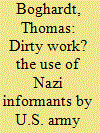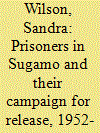|
|
|
Sort Order |
|
|
|
Items / Page
|
|
|
|
|
|
|
| Srl | Item |
| 1 |
ID:
138442


|
|
|
|
|
| Summary/Abstract |
After World War II ended in 1945, U.S. Army intelligence agencies, especially the Counter Intelligence Corps, recruited former Nazi officials, war crimes suspects, and war criminals to collect information on communist party and Soviet activities in Europe. While studies have examined individual cases, this article seeks to establish the historical context of the early Cold War that set the framework for this intelligence exploitation. It also weighs the intelligence value of the Army’s Nazi informants and reviews recruitment by other American and Allied intelligence services. Finally, it discusses the challenges of using ethical guidelines in recruiting secret agents, during the early Cold War and beyond.
|
|
|
|
|
|
|
|
|
|
|
|
|
|
|
|
| 2 |
ID:
151701


|
|
|
|
|
| Summary/Abstract |
Insurgencies thrive in regions where government legitimacy is absent. In the post-war Philippines, Captain Charles T. R. Bohannan of the Army’s Counter Intelligence Corps became actively aware of this dynamic. Bohannan is best known for his later work with Edward Lansdale and Ramon Magsaysay in defeating the Huk Rebellion (1950–1954). Here the author examines Bohannan’s early investigative work against Japanese war criminals, wartime Filipino collaborators, and the rising threat of communist subversion most associated with the Huk. All of these experiences fed into what would be the successful campaign against the Huk, chronicled in his seminal work, Counter Guerrilla Operations: The Philippines Experience, and offers lessons on the investigative (as opposed to tactical or psychological) nature of effective counter-insurgency work, as it relates to both legitimacy in governance and the rise of insurgencies.
|
|
|
|
|
|
|
|
|
|
|
|
|
|
|
|
| 3 |
ID:
106798


|
|
|
|
|
| Publication |
2011.
|
| Summary/Abstract |
The great majority of Japanese war criminals served part or all of their sentences in Sugamo Prison in Tokyo, either because they had been tried in Japan, or after repatriation from overseas. Once convicted, they tended to be invisible in historical accounts of the post-war period, but in fact they were not cut off from Japanese society or politics in the 1950s. Rather, Sugamo's inmates worked hard to win public sympathy, also exerting considerable pressure on the government in an attempt to hasten their own release and to have Japanese prisoners repatriated from overseas gaols. The early 1950s were crucial, not least because the 1952 peace treaty stipulated that the countries that had originally prosecuted them retained the right to decide on prisoners' fates even after Japan regained its sovereignty. Moreover, convicted war criminals were increasingly concentrated in Sugamo, allowing many opportunities for political activity and other campaigning. Though the last war criminals were not freed until 1958, prisoners' activities in the early 1950s played an important part in changing the terms in which discussion of war criminals took place and thus in making it more and more difficult for foreign governments to maintain their original stance on war criminals.
|
|
|
|
|
|
|
|
|
|
|
|
|
|
|
|
|
|
|
|
|